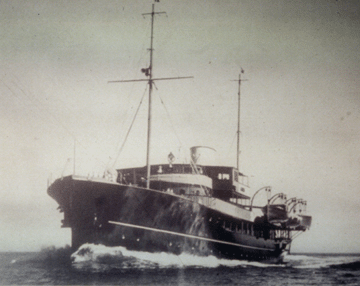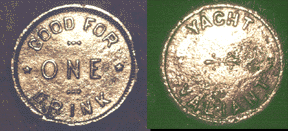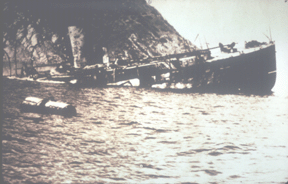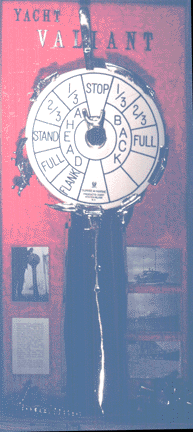Valiant
| Other Names: | Date of Sinking: 12/13/1930 | |||
| Rig/Type: Yacht | Cause of Sinking: Fire | |||
| Length: 162' | Breadth: 26' | Tons: | Cargo: None | |
| Built: 1926 | Location: Off Descanso beach, Catalina | |||
| Hull Construction: Steel | Depth: 70-100' | Visibility: 30-90' | ||

Valiant Wreck
By Bonnie Cardone
The Valiant was launched on the East Coast in 1926 and went to her grave just four years later in December 1930. She was a 162 foot long luxury yacht with a 26 foot beam, 13 tiled bathrooms and a playroom for the owner’s children. She was christened the Aras (the owner’s wife’s name spelled backward).
Not many months after she was launched, her owner, Hugh Chrisholm, sold her to Charles
Howard of Howard Motor Company, who renamed her, the Valiant. Her homeport
became San Francisco, but she was a frequent visitor to Santa Barbara, Los Angeles, and
Catalina. When her guests went into Avalon, the Valiant’s owner gave them
"Good for One Drink" tokens, which he would redeem when he went into town.

On the evening of December 13, 1930, the Valiant was anchored in Descanso Bay. The Howards their guests were enjoying cocktails and dancing in the salon; some of the crewmembers were playing cards. The lights flickered and went out. The gas generator had run out of fuel. One of the crewmembers ran down to the engine room and turned on the tap, but anxious to play his hand, didn’t wait for the fuel tank to fill. While he was playing cards, the tank overflowed and gasoline flooded the floor of engine room. A spark set it on fire. Within minutes, the boat was ablaze. The ship’s baker fell into a crack that opened in the deck. Rescued, he would spend several days in the Avalon hospital. He and the other 27 passengers and crew boarded a lifeboat and escaped to shore.
The harbormaster tried to tow the Valiant away from other boats moored in the area but didn’t get very far. The port anchor came loose and went to the bottom, anchoring the burning vessel to the sea floor. The fire raged for three days. When it finally burned the metal hull plates were cooled by the seawater and shrank; the ocean rushed in and the boat went to the bottom.

Over the years the Valiant has been salvaged extensively, both by amateurs and professionals. Mel Fisher, then owner of Mel’s Aqua Shop, practiced his salvage techniques by removing one of the ship’s propellers. Mel would find a Spanish galleon laden with treasure in 1987.
Lots of artifacts were salvaged: the ship’s telegraph, boarding plate, commission plate and door hardware, along with Good for One Drink tokens, and many, many, keys and tiles from the 13 bathrooms.

Since the wreck is more than 50 years old, however the taking of any artifacts from her now is illegal.
I made my first dive on the Valiant in about 1974, before I began keeping a log. There was a great deal of the superstructure left then, but it was collapsing. My next dive on her was in 1981. By then, the superstructure was gone and the hull had numerous gaping holes in it. At the time, boats dropped their anchors right in the wreck because it provided better purchase than the sand surrounding it. When the anchors were raised, they often brought up parts of the wreck.
The Valiant is one of the easiest wreck dives. She is an oasis in the sand, almost always kept company by a cloud of blacksmith. Her stern is at the bottom of a sandy slope in 70 feet; her bow points due north in 100 feet of water. Since she’s on the leeward side of Catalina, the ocean is nearly always calm. If there is any current it will most likely sweep from bow to stern and be gentle.
The Valiant’s bow and stern retain their distinctive shapes (the stem is round, not square) and the outline of the hull is clearly visible as you descend on her. In the collapsed midships area a mini kelp forest has sprouted.
A few feet of the main deck survive at the bow and at the stem. At the stem, several colorful gorgonians grow on it. If you don’t bring a light or a strobe, what remains of the hull will look brown and lumpy. A light however, will reveal the lumps are really marine life, some of it quite colorful. There are clubtipped anemones, colonial cup and solitary cup corals, lightbulb tunicates, jewel boxes and -scallops as well as Christmas tree worms in red, yellow and blue. Look also for bright yellow en-crusting anemones.
Any mollusks seen on the Valiant will have a rusty tint, particularly obvious on chestnut cowries, because of the rust from the hull.
The best time to dive the Valiant is in the winter, when boat traffic is at a minimum. Whether you dive from boat or shore, however, you must get permission from the Harbormaster. His office is at the end of the Green Pleasure pier in Avalon.
The Valiant is an easy shore dive, again, only with prior permission from the harbormaster. There are three rows of mooring buoys in Descanso Bay, the Valiant is between buoys 45 and 46 in the row that’s farthest from shore. As you face the sea, head for the third buoy from the right. When you get there, descend along the buoy’s chain to 80 feet. If you can’t see the wreck, swim east about 100 feet. If that doesn’t bring you to the wreck, swim 100 feet west of the mooring buoy.
| Left: Adiver investigates the wreck. Right: Plating has deteriorated, leaving behind large holes in the hull. |
The bow of the Valiant rises some twenty feet of the ocean floor, 110 feet deep. |
| Like to learn more about this wreck? Visit our Guest Page to submit your inquiry. |
